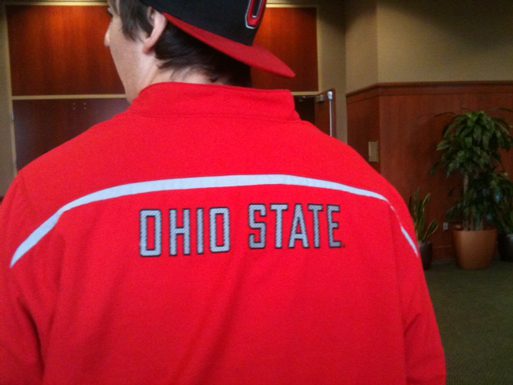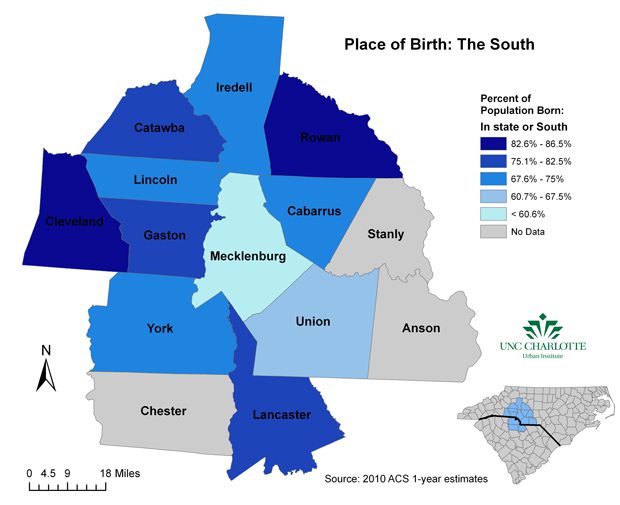You’re not from around here, are you?

If you grew up in the Charlotte region, it was common to hear this question, if your accent or mannerisms did not fit with the expected Southern norms: You’re not from around here, are you?
Through the 1990s and into the mid-2000s, the Charlotte region experienced a dramatic wave of in-migration that changed its demographics in many ways. While a substantial portion of this influx came from outside the U.S., newcomers from other parts of the U.S. had a larger impact. Analysis of Census Bureau and Internal Revenue Service data by the Brookings Institute released in October shows the wave of migration ebbed in the later part of the decade for some groups moving to Charlotte, but the changes to the region have been substantial. The region’s population now has a new diversity of origins from within the country and abroad.
The newcomers have brought their food, their loyalty to far-flung sports teams, ways of doing business and attitudes about education. What does this mean for the culture of Charlotte and environs? How Southern is the local character today?
The map above shows the percentage of population born in the South for counties in the Charlotte region.* The center of the region, Mecklenburg County, home to Charlotte, now has the lowest proportion of Southern-born population, about 60 percent. Explore the interactive map (by clicking the map image above), and you will Mecklenburg also has the highest proportion of foreign-born residents.
 The other interactive maps show the population by U.S. region of birth. Newcomers to the Charlotte region from the Northeast make up the largest group, with Midwesterners the next largest domestic group. Union County, the rapidly growing suburban county just southeast of Mecklenburg, has the second highest proportion of Northeasterners, 14.1 percent. In several counties (Mecklenburg, Union, Linclon, Catawba and Rowan) there are a higher percentage of people born outside the U.S. than in the Midwest.
The other interactive maps show the population by U.S. region of birth. Newcomers to the Charlotte region from the Northeast make up the largest group, with Midwesterners the next largest domestic group. Union County, the rapidly growing suburban county just southeast of Mecklenburg, has the second highest proportion of Northeasterners, 14.1 percent. In several counties (Mecklenburg, Union, Linclon, Catawba and Rowan) there are a higher percentage of people born outside the U.S. than in the Midwest.
The table below shows the breakdown of 11 regional counties by their population’s place of birth for the year 2010. Five counties (Mecklenburg, Union, Cabarrus, York and Iredell) have populations from the combined areas of the Northeast, Midwest and West of more than 20 percent, which puts them above the N.C. state percentage from those regions, 18.2 percent. York County, S.C., shows a high proportion of newcomers from within the U.S., but a lower percentage of foreign born. Westerners are here in lower numbers overall, but Union, Cabarrus and Lincoln have higher percentages of Westerners than Mecklenburg.

Mecklenburg and Union counties, with the most newcomers in the region, are nearly identical in their combined population of U.S. born newcomers from outside the South, at just under 25 percent. The major difference between these two counties, in terms of birthplace, is the percentage of foreign-born people. Mecklenburg’s foreign-born population is well above any other regional county, 13.3 percent, with Union County second-highest in this category, at 8.1 percent.
Tom Hanchett of Charlotte’s Levine Museum of the New South says, “Charlotte is a city of newcomers. That’s always been true, mostly because we have always been a trading city, which means strong business ties beyond our own community. Many of our key leaders were born elsewhere, from D.A. Tompkins, the biggest 19th-century mill builder, to Hugh McColl, the biggest 20th-century banker, both of whom arrived from rural South Carolina.
“But what’s going now is dramatically different than even a generation ago. The South in general, and ‘banktown’ Charlotte in particular, has recently become an economic magnet. No longer are people leaving the South to find opportunity in the urban North as they did for most of the 20th century. Today newcomers are arriving here from across the U.S. and around the globe.”
Now, with counties in suburban Charlotte showing such dramatic growth in newcomers from across the country, the area of impact to culture and norms is expanding. Within our region, however, the makeup of the local population varies significantly, from 61 percent Southern-born in Mecklenburg, to 87 percent in Cleveland.
Tom Hanchett observed, “[These] maps make visible some unseen divisions in our region. Depending on where you live, your daily interactions can be quite different, and thus your perspectives on what our local culture is – and where we might be going as a community. “
So, depending on where you are in the region, that old question, “You’re not from around here, are you?” – with its implication that we don’t get strangers around these parts – is more and more likely to be fading into history.
* Data for these maps come from the Census Bureau’s American Community Survey 1-year estimates for 2010. Anson, Chester and Stanly counties fall below the population threshold for 1-year estimates, so are not available.
